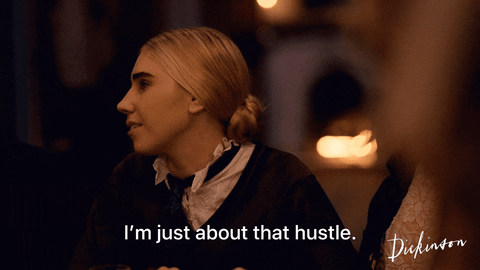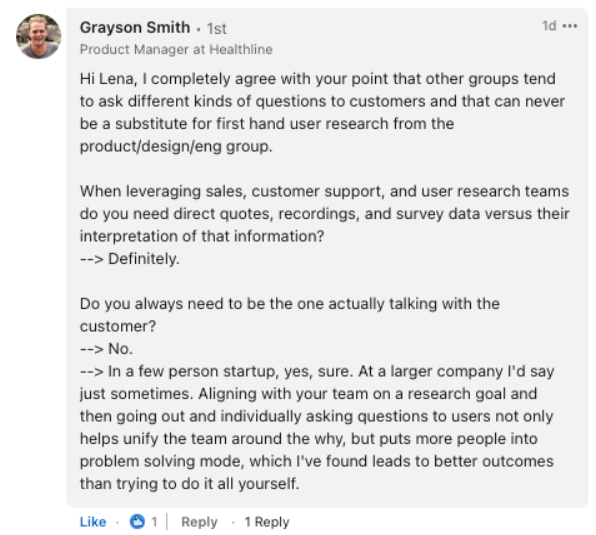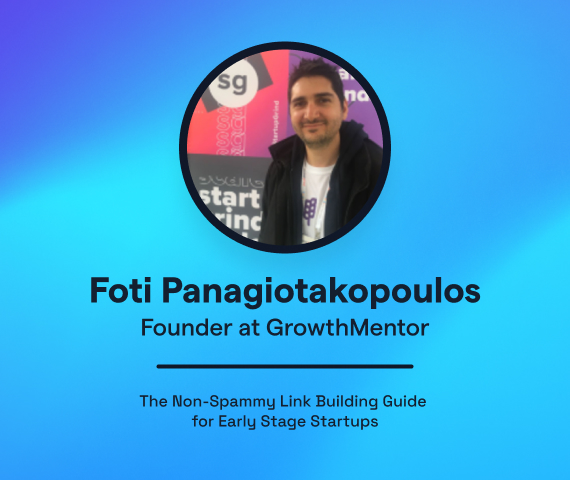The 7 dark sides of being a product manager (and how to deal with them)
“I want to be a product manager!” they said.
“I’ll get to be the CEO of the product and build cool stuff!” they said.
Well, it’s not as straightforward as that.
As with any role, there are some tough aspects to being a product manager. And if you’re not careful, they can take a toll on your mental health.
But most product managers don’t talk about the dark sides of being a product manager.
So I’m going to walk you through the seven dark sides of being a product manager and how to deal with them.
Dark side #1: The responsibilities and boundaries of the Product Manager role are often unclear.
In my first ever role as a product manager, our team’s motto was “we do what we must.” I was part of a tiny new startup-like team within a Fintech org that was bringing a brand new product to market.
In a way, we did need to “do what we must” — most startups do! But I took this to a whole other level:
- I wrote code
- I fixed production issues
- I created project plans
- I streamlined our tech support process
- I did QA testing
- I trained QAs
- I helped solve development pipeline issues
- I tailed application server logs
You name it, I was down to do it!
I basically removed any boundaries to my role and did it all because it made me feel superhuman.
I thought I was so cool at the time and would brag about how much overtime I was working. Yup, I was the poster child for hustle culture.
As anyone could guess out of an airplane window, I eventually burnt out. Hard. Multiple times.
It wasn’t until years later that I finally realized: The responsibilities of a product manager can be ambiguous. And my young, overly ambitious self had fallen prey to the lack of boundaries and burnt out.
The truth is, what you do and what you’re responsible for as a product manager can differ greatly depending on:
- The industry you’re in
- The company you work for and its culture
- Where product management sits within the organization
- The style and priorities of senior leadership
- The product itself and where it is in the product lifecycle
- The makeup of adjacent roles and teams (designers, business analysts, product marketers, customer success, etc.)
- The relationship between product management and engineering in the org
And a million other things.
This inconsistency across different product manager roles is what creates ambiguity in the role, making it extremely difficult to define the boundaries of your role. There’s simply no standard; no yardstick to measure with. This can lead to frustration, unsettling feelings, and of course burnout.
One reason for this ambiguity is that the field of product management is still relatively immature compared to fields like engineering or accounting. This can make being a product manager a bit of a mixed-bag experience — it often has been for me.
The second reason for the inconsistency is that many companies don’t yet fully understand the true value of a product manager. As a result, many product managers are reduced to “backlog groomers” or “glorified project managers.” This is worlds apart from the experience of a product manager working in a mature product organization where they’re given a lot of autonomy to make decisions about the product.
Call me crazy, but I wouldn’t say I regret burning out in my first role as a product manager. I learned an unimaginable amount about building software, working with software developers, and talking to customers in a way that makes them feel heard. I also developed a strong sense of grit because of what I went through and grew my career in tech.
But I’ve made a promise to myself since then to never go that hard again. And so far, I’ve kept my promise for the most part.
Although, as one of my mentors put it: “We’re drawn to the fires.”
Tips for mitigating dark side #1 of being a product manager:
- Set clear expectations of your responsibilities and the outcomes you’re meant to drive with your manager and senior leadership.
- Constantly explain what you do for your team, adjacent teams, stakeholders, etc. Repetition creates alignment.
- Create a Team Manifesto document that clearly outlines who is responsible for what.
- When accepting tasks outside of the pre-set boundaries of your role, make it clear that’s what you’re doing with statements like: “This isn’t typically my role, but I can step in this time.”
Dark side #2: Your days are often filled with meetings, leaving you little to no focus time.
They say product managers need to block out time to think about vision and strategy.
But for many product managers, this is next to impossible. You’re constantly being pulled into various conversations to solve different problems. This is especially true if you haven’t yet been able to set clear boundaries for your role.
I’ve even heard of product managers whose bosses encourage them to block focus time, but end up booking meetings with them during that time anyway.
To make things worse, the global COVID-19 pandemic has exasperated the situation for product managers because most companies still don’t know how to do remote work right. They fail to leverage asynchronous communication in a remote environment and tend to default to scheduling meetings all day to solve problems.
Tips for mitigating dark side #2 of being a product manager:
- Turn weekly update meetings into weekly update emails and only schedule a meeting to discuss specific issues or drive decisions.
- Send information ahead of meetings so you can use meeting time for decision-making or productive discussions.
- Learn how to politely decline meeting invites for which you don’t need to be in — here’s a document I created on How to Politely Decline Meetings to help you.
- Block your calendar for focus time a few hours a week and reject all meeting invites during those times.
- Colour-code your calendar so you can see what your day is comprised of at a glance and rank meetings or tasks as needed. I like to use different colours for different projects and also to differentiate between recurring meetings and one-off meetings.
Dark side #3: Everything always takes longer than you think; especially software development.
This was one of the hardest lessons I learned as a product manager. It was a source of major stress for me for years because of the pressure I’d get from customers or stakeholders to ship features faster and faster.
I used to question my developers on why things took so long, ask for constant updates and will them to code faster in my mind.
This doesn’t work. All it does is chip away at your developers’ trust in you and waste your energy.
Years later, I’ve finally accepted that the speed at which my development team solves problems and builds software is largely out of my control. As long as I’ve identified dependencies, broken down their tasks properly, and clearly defined all necessary acceptance criteria, I kick back, relax, and focus on something I can control, instead.
What helped me get to this point was grasping the fact that software development is a totally ambiguous endeavour and empathizing with developers on this. They simply can’t predict what issues or challenges they might run into — and that’s not their fault.
Another mindset shift that helped me was understanding that dealing with the pressure from customers and stakeholders (and sometimes senior leadership or adjacent teams) to ship things faster is literally my job as a product manager. And I just had to find a way to proactively manage their expectations so I could shield my development team.
Ironically, doing my actual job (managing stakeholder expectations) was what enabled me to speed up my development team’s velocity in the end.
Tips for mitigating dark side #3 of being a product manager:
- Don’t react to development estimates with shock — your developers will shut down and you’ll lose their trust.
- Encourage developers to pad their estimates so you can underpromise and overdeliver to customers and stakeholders.
- Backlog refinement meetings are your best friend. Use them to fully break down tasks and identify all dependencies so your estimates are as accurate as possible.
- Ruthlessly and violently prioritize the work — it’s easier to get things done when there’s less to do.
- Give your customers and stakeholders advance notice of delays and be transparent about how you’re prioritizing the work.
- Remember that sometimes the pressure is greatest from the people who don’t fully understand the process of software development. Calmly explain to them the challenges your team is facing and how your team is progressing through those challenges despite the unknowns.
Dark side #4: You have an enormous amount of responsibility without any direct authority.
As a product manager, you’re “the CEO of the product,” right?
Well, it depends.
First of all, I really hate that term. It makes product managers sound pompous. I’m using the term “the CEO of the product” purely in irony because it’s the reason many aspiring product managers tell me they want to become product managers.
Second of all, there are very few product managers I know who can truly call themselves “the CEO of the product.” And it’s taken them an incredibly long time to get to that level of authority.
They’ve had to prove that their approach to problem-solving and decision-making is sound, over and over again… and have lost many battles along the way.
The truth is, product managers simply aren’t born into this world with an innate authority over others. We’re not CEOs because nobody actually reports to us. This means that nobody actually has to listen to us unless they truly believe in what we’re trying to do.
So, in the absence of traditional authority, product managers have to learn to lead with influence instead.
This is an extremely arduous process that involves gently nudging engineers, designers, directors and VPs in the direction of our vision over a long period of time. And patiently explaining the logic behind our decisions when faced with pushback. And occasionally leaving things to be done in a way we don’t feel is ideal… because we don’t have 100% authority.
The influence that comes with being trusted and respected as a product manager is very much earned over time.
Now for the most bewildering (and slightly unfair) part.
Despite not having direct authority over anything or anyone, product managers are responsible for the success of the product right from the beginning. And bear the burden of that, oftentimes on their own.
This is arguably the hardest and most stressful part of being a product manager.
Managing all this responsibility without any authority (at least in the early days) requires a mountain of patience, resilience, and perseverance. It can be quite taxing mentally and can lead to feelings of inadequacy and imposter syndrome.
Even once you do earn influence as a product manager, there will still be things you can’t control like:
- The market and what customers truly need
- Systemic issues within the organization
- Inefficiencies within adjacent teams
- Low-performing team members
Again, all of this can seriously impact your success as a product manager. So you have to learn to actively manage these uncertainties and inconveniences without getting flustered.
Just like any other leadership position, respect and credibility are earned over a long period of time but can be shattered in a moment if you don’t play your cards right. (Never mind the fact that you were dealt a bad hand.)
Tips for mitigating dark side #4 of being a product manager:
- In the early days before you have much influence, focus on driving outcomes (even small wins) as quickly as possible and make them known to the greater org.
- Build relationships by understanding what drives each person and learning how to ask for and return favours.
- Create promoters within the org by keeping in close touch with people who believe in you early on and letting them in on your future plans.
- Accept that you can’t count on everyone to do their job perfectly. People vary in their abilities, levels of motivation, and styles of working — manage your expectations accordingly and make the most of each person’s work.
- When resistance is too much, take a step back.
Dark side #5: You’re often at the mercy of the Tone at the Top.
I recently came across the term ‘Tone at the Top’ in a LinkedIn article titled Thoughts on the “Dark Side” of Product Management by Casey Flinn. Casey’s idea is that product managers are often judged by the quality of their product leadership within the organization.
If your product leadership is well-respected in the organization, collaborates effectively with other departments and drives valuable results, individual product managers will greatly benefit from this positive reputation. And are more likely to get buy-in for their product vision and roadmap from the rest of the organization.
However, if the Tone at the Top is negatively perceived by the rest of the organization, it makes a product manager’s life more difficult. It infringes on the product manager’s ability to gain trust from the rest of the organization and rally everyone around their vision. Even if other teams trust the individual product manager, their lack of trust in the product leadership can make the product manager’s efforts futile.
This is certainly a valid point and I’ve experienced this myself in the past. But I have another interpretation of the Tone at the Top. It’s that individual product managers are at the mercy of the decisions and dysfunctions of their product leadership.
A product manager could have the best product vision, create a well-thought-out product roadmap, and rally everyone around these things. But if a dysfunctional product leader or a controlling startup founder or CEO suddenly decides they want to go in a different direction, they can inadvertently reverse the product manager’s efforts. And potentially damage the product manager’s credibility within the organization they’ve worked so hard to obtain.
Or let’s say there are systemic issues within the organization that are setting an individual product manager up to fail and a dysfunctional product leader fails to correct them (or even acknowledge them.) This can prevent an individual product manager from successfully executing their product vision and feeling proud of their work.
I know I’m painting a dark picture here. And the outcomes aren’t always this dire just because your product leadership is a little bit dysfunctional.
But even small ripple effects of bad product leadership can have a negative impact on a product manager’s motivation and confidence.
I’ve spoken to countless product managers who’ve felt they can’t be successful under these circumstances. And many of them went on to find other opportunities.
What’s brutal is that it’s not always the product leadership’s fault. As I said, product management is still an immature field. And given all the inconsistencies and ambiguity surrounding the role of a product manager, it’s hard to be a good product leader.
I know one thing for sure, though: A good product leader needs to be close enough to the ground to see what’s going on. That’s how they can fix issues proactively instead of reactively.
Tips for mitigating dark side #5 of being a product manager:
- Don’t pick fights with your product leadership or go directly against what they’re trying to do. Find ways to align with them and slowly influence their ways of thinking.
- Dig deep to understand what your product leadership’s deepest worries and fears are. Understanding what they’re dealing with can make you feel more empathetic and better accept their decisions.
- Connect with people in other parts of the organization who think the same way you do and create bridges. They can help you strengthen your arguments and reinforce the fact that you’re on the right track.
- Spend time understanding what you can control and what you can’t control. And focus only on what you can control.
- Experiment by mentoring or coaching people on your team in ways you think will maximize their success. Leading by example is the best antidote to bad leadership.
Dark side #6: You likely won’t get to talk to customers as much as you want to or expect to.
The only time I’ve gotten to talk to customers directly as a product manager was when I led an innovation team in 2019. The company I was working at had formed this innovation team in an effort to create a more customer-obsessed culture.
Before this experience, I’d built several products as a product manager without having the chance to talk to my target customers directly. I was asked to use other teams who talk to customers directly as proxies, instead.
If you’re shocked right now, you shouldn’t be.
The truth is, many product managers I know don’t speak to their customers directly either. Instead, they rely on proxies like the sales team, customer success folks, or even executives (the worst proxy of all) to understand customer needs.
Some product managers just don’t know any better and think that proxies can give them all the insights they need. They don’t understand that adjacent teams apply a different lens than a product manager would when speaking with customers. For example, a salesperson whose goal is to sell the product to more customers will ask different questions from a product manager who’s looking to build a new product.
Even in cases where the goals of a product manager align with the goals of an adjacent team, a lot can get lost in translation if you rely on them for customer insights.
I can’t really blame product managers who fail to see the missed opportunity of relying on proxies to understand their customers — many other product managers they talk to do the exact same thing! So they start to believe (mistakenly) that it’s an acceptable norm for product managers.
But most product managers know that not talking to your customers directly isn’t the best practice in product management. They simply don’t get to talk to their customers directly because of their company’s culture or the sheer amount of red tape involved in doing so. And as a result, the quality of their products suffers — a soul-crushing experience.
The antidote to this is to renegade your way past the red tape and try to reverse the company’s culture. While being a renegade can be fun, it’s a challenging and mentally draining experience.
This is what I was hired to do when I ran my innovation team in 2019. If you’re interested in learning more about my experience, I gave a talk about it at Userpilot’s Product Drive conference in 2021 called Fighting Imposter Syndrome & Dealing With Pushback on Innovation.
Tips for mitigating dark side #6 of being a product manager:
- Start by asking to be a fly on the wall when adjacent teams meet with customers.
- Recognize that other teams are doing important work and make an effort to understand their process. This will help you find a way to talk to customers without disrupting other teams.
- Educate adjacent teams on the importance of direct customer feedback for product managers and find a way to align your goals (you both want the product to succeed!)
- As soon as you get a win that resulted from talking to customers directly, showcase it around the company and use it to support future business cases.
- If the resistance is too much or the company is simply too big and not everyone can talk to customers directly, collaborate closely with multiple proxies to align on what customer insights you need and get direct quotes or recordings whenever possible.
Dark side #7: It can be a lonely and thankless job without nearly enough support.
Part of your job as a product manager is to shield your team from distractions so they can focus on building quality software. Because of this, you often end up taking on a lot of the pressure from customers and stakeholders yourself. This can become a burden over time and occasionally even create resentment.
Despite the notion of team accountability that everyone raves about, the product manager is primarily accountable for the overall success of the product. This can often make us feel like it’s our fault when things don’t work out.
The only people who can truly understand what we’re going through and make us feel less alone in our struggles are other product managers. But sadly, they aren’t always available to help us. They’re busy with their own products and already have enough meetings as it is.
In my almost five years of experience as a product manager, I’ve only closely collaborated with a few product managers. I wish it were more and hopefully, it’s different for you.
Without as much collaboration with other product managers as we’d like, the result is a bit of a lonely existence — similar to what the job of a CEO is like, ironically!
Now onto the ‘thankless’ part of the job.
A lot of what we do as product managers happens behind the scenes and isn’t immediately visible to the rest of the organization. This creates an illusion that we wave our hands and things magically get done. Not everyone sees the blood, sweat and tears that went into shipping a new feature or a critical fix.
And despite all this hard work, it can often feel like the product is never good enough. There are always more problems to solve, more bugs to fix, and more metrics to optimize. The work literally never ends. This is because software is never complete and can always be improved.
This can make being a product manager feel like a pretty thankless job.
And even when things do finally work out, and customers and stakeholders are happy, we as product managers don’t typically take the praise ourselves. Instead, we highlight all the hard work the team has done. Because we truly couldn’t have done it without our team and we hate sounding big-headed.
This quote from Abhishek Sharma nicely sums this concept up:
“The role of a PM is to redirect praise to the people who deserve it and absorb blame.” — Abhishek Sharma on The dark side of the product management role.
A little extreme, I know. But there are elements of the truth there.
So what’s the takeaway from all this? Well, if you want to be a product manager, you need to derive a lot of internal satisfaction from your work. Because you’re likely not going to get all the praise that you think you deserve.
Tips for mitigating dark side #7 of being a product manager:
- Build close relationships with one or two other product managers in your company and proactively reach out for catch-up chats and work through challenges together. They’re your best bet for feeling heard and less alone.
- Ruthlessly and violently prioritize your tasks and get comfortable with leaving some fires burning. You can’t get to everything so don’t try to.
- Find mentors you can talk to about your challenges. Don’t carry the burden on your own.
- Celebrate both small and big wins as much as you can, as often as you can. You need to taste victory frequently to stay motivated.
- Look at your team’s success as evidence of your strong leadership — their work wouldn’t be possible without you!
Wrapping up with the brightest side of being a product manager
Now that we’ve traversed the seven dark sides of being a product manager, I want to share with you the brightest side of being a product manager:
It’s the ultimate job for becoming a better leader and learning about who you really are.
Given the sheer amount of different people you get to interact and work with, you become really good at reading people and figuring out the why behind what they’re trying to do. And finding ways to align people despite their differences.
And when you learn how to lead better, you learn more about yourself — how you react to problems, how you make decisions, and how you pick yourself back up when you fall.
Despite these seven dark sides I’ve divulged, being a product manager is a rollercoaster worth strapping into because you come off it a better and grittier person.












